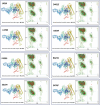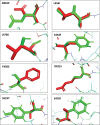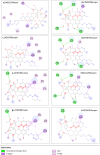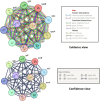Adoption of an in-silico analysis approach to assess the functional and structural impacts of rpoB-encoded protein mutations on Chlamydia pneumoniae sensitivity to antibiotics
- PMID: 40102727
- PMCID: PMC11921668
- DOI: 10.1186/s12866-025-03860-5
Adoption of an in-silico analysis approach to assess the functional and structural impacts of rpoB-encoded protein mutations on Chlamydia pneumoniae sensitivity to antibiotics
Abstract
Background: Antibiotics are frequently used to treat infections caused by Chlamydia pneumoniae; an obligate intracellular gram-negative bacterium commonly associated with respiratory diseases. However, improper or overuse of these drugs has raised concerns about the development of antibiotic resistance, which poses a significant global health challenge. Previous studies have revealed a link between mutations in the rpoB-encoded protein of C. pneumoniae and antibiotic resistance. This study assessed these mutations via various bioinformatics tools to predict their impact on function, structural stability, antibiotic binding, and, ultimately, their effect on bacterial sensitivity to antibiotics.
Results: Eight mutations in the rpoB-encoded protein (R421S, F450S, L456I, S454F, D461E, S476F, L478S, and S519Y) are associated with resistance to rifampin and rifalazil. These mutations occur in conserved regions of the protein, leading to decreased stability and affecting essential functional sites of RNA polymerase, the target of these antibiotics. Although the structural differences between the native and mutant proteins are minimal, notable changes in local hydrogen bonding have been observed. Despite similar binding energies, variations in hydrogen bonds and hydrophobic interactions in certain mutants (for instance, D461E for rifalazil and S476F for rifampin) indicate that these changes may diminish ligand affinity and specificity. Furthermore, protein-protein network analysis demonstrated a strong correlation between wild-type rpoB and ten C. pneumoniae proteins, each fulfilling specific functional roles. Consequently, some of these mutations can reduce the bacterium's sensitivity to rifampin and rifalazil, thereby contributing to antibiotic resistance.
Conclusion: The findings of this study indicate that mutations in the rpoB gene, which encodes the beta subunit of RNA polymerase, are pivotal in the resistance of C. pneumoniae to rifampin and rifalazil. Some of these mutations may result in reduced protein stability and changes in the structure, function, and antibiotic binding. As a consequence, the efficacy of these drugs in inhibiting RNA polymerase is compromised, allowing the bacteria to persist in transcription and replication even in the presence of antibiotics. Overall, these insights enhance our understanding of the resistance mechanisms in C. pneumoniae and could guide the development of strategies to address this challenge.
Clinical trial number: Not applicable.
Keywords: Chlamydia pneumoniae; RpoB gene; Antibiotic; In Silico analysis; Mutations; Resistance.
© 2025. The Author(s).
Conflict of interest statement
Declarations. Ethics approval and consent to participate: Not applicable. Consent for publication: Not applicable. Competing interests: The authors declare no competing interests.
Figures









Similar articles
-
Emergence of resistance to rifampin and rifalazil in Chlamydophila pneumoniae and Chlamydia trachomatis.Antimicrob Agents Chemother. 2005 Mar;49(3):903-7. doi: 10.1128/AAC.49.3.903-907.2005. Antimicrob Agents Chemother. 2005. PMID: 15728882 Free PMC article.
-
Rifalazil retains activity against rifampin-resistant mutants of Chlamydia pneumoniae.J Antibiot (Tokyo). 2008 Aug;61(8):489-95. doi: 10.1038/ja.2008.65. J Antibiot (Tokyo). 2008. PMID: 18997387
-
Rifampin Resistance rpoB Alleles or Multicopy Thioredoxin/Thioredoxin Reductase Suppresses the Lethality of Disruption of the Global Stress Regulator spx in Staphylococcus aureus.J Bacteriol. 2016 Sep 9;198(19):2719-31. doi: 10.1128/JB.00261-16. Print 2016 Oct 1. J Bacteriol. 2016. PMID: 27432833 Free PMC article.
-
Development potential of rifalazil and other benzoxazinorifamycins.Expert Opin Investig Drugs. 2006 Jun;15(6):603-23. doi: 10.1517/13543784.15.6.603. Expert Opin Investig Drugs. 2006. PMID: 16732714 Review.
-
Rifalazil and other benzoxazinorifamycins in the treatment of chlamydia-based persistent infections.Arch Pharm (Weinheim). 2007 Oct;340(10):517-29. doi: 10.1002/ardp.200700080. Arch Pharm (Weinheim). 2007. PMID: 17912677 Review.
References
-
- Bachmann NL, Polkinghorne A, Timms P. Chlamydia genomics: providing novel insights into chlamydial biology. Trends Microbiol. 2014;22(8):464–72. 10.1016/j.tim.2014.04.013. - PubMed
-
- Nunes A, Gomes JP. Evolution, phylogeny, and molecular epidemiology of Chlamydia. Infect Genet Evol. 2014;23:49–64. 10.1016/j.meegid.2014.01.029. - PubMed
-
- Vorimore F, Hölzer M, Liebler-Tenorio EM, Barf L-M., Delannoy S, Vittecoq M, et al. Evidence for the existence of a new genus Chlamydiifrater gen. nov. inside the family Chlamydiaceae with two new species isolated from flamingo (Phoenicopterus roseus): Chlamydiifrater phoenicopteri sp. nov. and Chlamydiifrater volucris sp. nov. Systematic and Applied Microbiology. 2021 Mar 30;44(4):126200. 10.1016/j.syapm.2021.126200 - PubMed
-
- Hammerschlag MR, Kohlhoff SA, Gaydos CA. Chlamydia pneumoniae. In: Bennett JE, Dolin R, Blaser MJ, editors. Mandell, Douglas, and Bennett’s principles and practice of infectious diseases. 8th ed. Philadelphia: Elsevier; 2015. pp. 2174–e21822. 10.1016/B978-1-4557-4801-3.00184-3
MeSH terms
Substances
LinkOut - more resources
Full Text Sources
Medical
Research Materials

